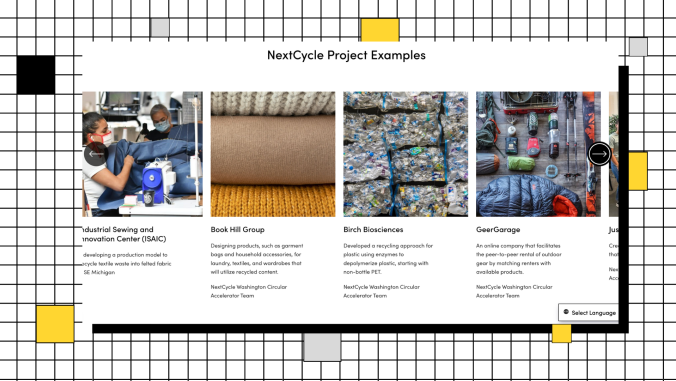The North Face aims to increase its circularity
The outdoor recreation product company is expanding its Renewed recommerce program.

Label created for refurbished item from The North Face's inaugural Renewed Design Residency program workshop.
The North Face is aiming to rev up its investment in circular design principles and practices, with an expansion of its The North Face Renewed program.
First launched in June 2018, The North Face Renewed is a marketplace where consumers can purchase previously worn or returned clothing that has been repaired or refurbished.
As part of its latest circular economy initiative, the Renewed Design Residency, rotating groups of the company’s designers will attend workshops and immersion sessions multiple times a year at the Renewal Workshop, a company that helps apparel and textile companies. Renewal Workshop has worked with partners including Carhartt, Mara Hoffman and Osprey to help them evaluate circular solutions and learn more about how to design with principles of circularity in mind.
“It became really clear that we need to be better educated and take more responsibility for creating smarter products, since we have such an impact on the life cycle of a product through the choices that we make when we're building that product,” said Kellen Hennessy, senior designer at The North Face.
Hennessy was one of four designers who attended the inaugural Renewed Design Residency pilot workshop in October. During that session, the designers refurbished four garments that had been returned or damaged. To celebrate the launch of the residency, those items are being auctioned and 100 percent of the proceeds from those sales will go to The North Face Explore Fund, which gives money to environmental organizations.

"It really was pretty mind-blowing to go [to the Renewal Workshop] and see the challenges that they were facing in the work that they were doing, the skills that they had, and see all of it at scale, because it's one thing to kind of like know the stats [about] textile waste," Hennessy said. "But it's another thing to walk into a warehouse and see a ton of boxes and all these products that don't necessarily have a place to go."
An example of a circular design principle she and her colleagues explored is related to quilted panel shapes. Keeping the panels more straightforward and simple makes garments more repairable, she noted.
"It's a lot easier to repair a straight quilted channel than it is a more complex shape," Hennessy said. "So there's a lot of ways that I think we can take some of the learnings that we had to make products that are more durable, but also that can be more repairable."
When The North Face Renewed was launched a couple of years ago, it joined the likes of online recommerce marketplaces from Patagonia, REI and others. Since 2018, The North Face Renewed says it has diverted more than 200,000 pounds of clothing from landfills.
As more designers at the company embed circularity principles into their designs, there is the potential for even more products to be diverted because when returned, damaged or defective items are intentionally designed for reuse from the start, there is greater opportunity to reuse them in some way. Hennessy said that while the next workshop for designers is not set yet, it will take place during the first half of 2020.Our goal is to make durable products so that they stay in use longer. The Renewed program focuses on how we might bring products [back] that maybe would have gone to the landfill.
Amy Roberts, senior director of global communications and corporate social responsibility at The North Face, said the Renewed program and this expansion is just one approach the company is pursuing to continue to improve its sustainability, implement circular economy practices and reduce its footprint.
"Our goal is to make durable products so that they stay in use longer. The Renewed program focuses on how we might bring products [back] to us that maybe would have previously gone to the landfill," said Roberts, noting that The North Face also has a commitment to recycled content. So team members are also answering the question, "How do we really hit our goals around bringing more recycled content into our products, whether that's recycled nylon, polyester or cotton?"





